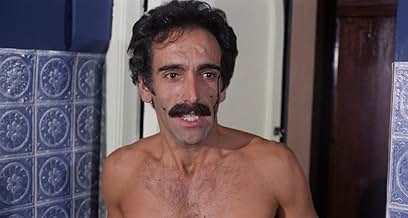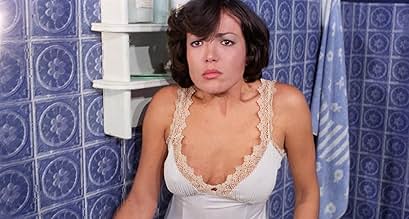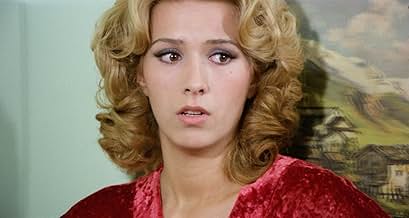अपनी भाषा में प्लॉट जोड़ेंA writer arrives to an isolated boardinghouse run by a beautiful but strange woman. Shortly after his arrival, guests start to get violently killed.A writer arrives to an isolated boardinghouse run by a beautiful but strange woman. Shortly after his arrival, guests start to get violently killed.A writer arrives to an isolated boardinghouse run by a beautiful but strange woman. Shortly after his arrival, guests start to get violently killed.
Heinrich Starhemberg
- Daniel
- (as Henry Gregor)
Tony García Jr.
- Young Boy
- (as Tony Garcia Pablo)
León Klimovsky
- Paisano
- (बिना क्रेडिट के)
फ़ीचर्ड समीक्षाएं
An accomplished writer arrives to a guesthouse near the lake in the middle of nowhere.Its owner is a young and obviously troubled woman.During the night a sexually active couple is slashed to death by a mysterious black-gloved killer.More savage murders follow.Who is behind them?"Trauma" by Leon Klimovsky reminded me a little bit S.F Brownrigg's underrated "Keep My Grave Open".All the killings via razor are vicious and bloody.There is plenty of sex and nudity-in fact "Trauma" is perhaps the sleaziest horror film made by Leon Klimovsky.The plot offers some genuine suspense and a bit of perversion and nasty misogyny.I enjoyed this rare and utterly forgotten slasher/giallo.8 razors out of 10.
There are some interesting ideas here. It's a whodunit with some Norman Bates moments and an ending that is open to interpretation which I thought was unique for this type of movie.
The lead actress, Ágata Lys, was great! The rest of the cast ranged from forgettable to bad.
I found the directing to be quite bad. It had a made for TV feel to it.
There's quite a bit of sleaze and nudity here. With the exception of the final murder, the violence and special effects were laughably bad. I thought the execution of the last girl's death was a cut above the rest.
The score was better than average.
I enjoyed the ambiguous ending.
The lead actress, Ágata Lys, was great! The rest of the cast ranged from forgettable to bad.
I found the directing to be quite bad. It had a made for TV feel to it.
There's quite a bit of sleaze and nudity here. With the exception of the final murder, the violence and special effects were laughably bad. I thought the execution of the last girl's death was a cut above the rest.
The score was better than average.
I enjoyed the ambiguous ending.
Iolación fatal is a grim, unsettling entry in the late-70s wave of Spanish exploitation cinema, wrapped in the aesthetics of a psychological thriller but weighed down by uneven execution. While the film touches on disturbing themes and presents a few stylistic flourishes, it struggles to rise above the genre's more gratuitous tendencies.
Atmospherically, the film succeeds in creating a sense of dread. The lighting is often stark and moody, particularly in interior scenes where shadows feel like silent observers. Cinematographer Francisco Sánchez captures a creeping tension in narrow hallways and dimly lit bedrooms, often allowing the frame to linger just long enough to unsettle. Yet, this stylistic care doesn't always carry through. Some scenes fall flat visually, with pedestrian compositions or abrupt edits that undercut their emotional weight. There's a disconnect between the visual intent and the rhythm of the narrative, which makes the film feel choppy at times.
Performance-wise, the cast handles the material with varying degrees of conviction. Ágata Lys delivers a haunting and layered performance, striking a delicate balance between vulnerability and restrained strength. Her presence anchors the film, elevating scenes that might have otherwise veered into exploitation without nuance. In contrast, some supporting actors fall into melodrama, lacking the subtlety the script seems to call for. Still, even with these inconsistencies, there's a raw sincerity in several exchanges that makes the human drama feel real, if not always well-paced.
The film's major flaw lies in its tendency toward sensationalism. At points, it leans heavily on nudity and lurid scenarios to provoke rather than explore. This often blunts the psychological depth the film flirts with, leaving some scenes feeling gratuitous instead of essential. There's an undercurrent of commentary about trauma and guilt, but it never fully matures into something cohesive. Instead, the movie circles its themes, hesitant to confront them head-on.
In the end, Violación fatal is a mixed bag. It has moments of genuine tension and some striking visual choices, but it lacks the narrative focus and restraint to elevate its subject matter. Ágata Lys's performance remains the most memorable element, a compelling center in a film that too often drifts toward exploitation without clear purpose.
Atmospherically, the film succeeds in creating a sense of dread. The lighting is often stark and moody, particularly in interior scenes where shadows feel like silent observers. Cinematographer Francisco Sánchez captures a creeping tension in narrow hallways and dimly lit bedrooms, often allowing the frame to linger just long enough to unsettle. Yet, this stylistic care doesn't always carry through. Some scenes fall flat visually, with pedestrian compositions or abrupt edits that undercut their emotional weight. There's a disconnect between the visual intent and the rhythm of the narrative, which makes the film feel choppy at times.
Performance-wise, the cast handles the material with varying degrees of conviction. Ágata Lys delivers a haunting and layered performance, striking a delicate balance between vulnerability and restrained strength. Her presence anchors the film, elevating scenes that might have otherwise veered into exploitation without nuance. In contrast, some supporting actors fall into melodrama, lacking the subtlety the script seems to call for. Still, even with these inconsistencies, there's a raw sincerity in several exchanges that makes the human drama feel real, if not always well-paced.
The film's major flaw lies in its tendency toward sensationalism. At points, it leans heavily on nudity and lurid scenarios to provoke rather than explore. This often blunts the psychological depth the film flirts with, leaving some scenes feeling gratuitous instead of essential. There's an undercurrent of commentary about trauma and guilt, but it never fully matures into something cohesive. Instead, the movie circles its themes, hesitant to confront them head-on.
In the end, Violación fatal is a mixed bag. It has moments of genuine tension and some striking visual choices, but it lacks the narrative focus and restraint to elevate its subject matter. Ágata Lys's performance remains the most memorable element, a compelling center in a film that too often drifts toward exploitation without clear purpose.
TRAUMA is a late entry in the career of Spanish horror director Leon Klimovsky. Like A DRAGONFLY FOR EACH CORPSE and BLUE EYES OF THE BROKEN DOLL, it's a Spanish-themed giallo, although the actual inspiration is much more obvious: like SISTERS before it, this is a film which owes its existence to Hitchcock's PSYCHO.
The setting is rural Spain and a slightly run-down boarding house occupied by the usual oddballs including a writer and a couple of sexed-up couples (well, it was the 1970s). Before long a series of brutal razor slayings are taking place, and the viewer is left wondering who's responsible. Well, not really; the identity of the killer is blindingly obvious from the outset, but this doesn't detract from the film's entertainment value. Brutal murders, violent flashbacks, and a sedate pace follow.
The huge bonus here is Klimovsky's exemplary direction; this is a guy who could take a low budget and always make his film look fantastic. A succession of effective establishing shots and an emphatic, low key score combine to give the whole film a sinister atmosphere. The photography is good enough to keep things interesting despite the slow pace and lack of action. The gore is a bit shoddy, but the film feels very brutal nonetheless, and the climax is worth waiting for.
The setting is rural Spain and a slightly run-down boarding house occupied by the usual oddballs including a writer and a couple of sexed-up couples (well, it was the 1970s). Before long a series of brutal razor slayings are taking place, and the viewer is left wondering who's responsible. Well, not really; the identity of the killer is blindingly obvious from the outset, but this doesn't detract from the film's entertainment value. Brutal murders, violent flashbacks, and a sedate pace follow.
The huge bonus here is Klimovsky's exemplary direction; this is a guy who could take a low budget and always make his film look fantastic. A succession of effective establishing shots and an emphatic, low key score combine to give the whole film a sinister atmosphere. The photography is good enough to keep things interesting despite the slow pace and lack of action. The gore is a bit shoddy, but the film feels very brutal nonetheless, and the climax is worth waiting for.
Trauma is very similar to Alfred Hitchcock's Psycho in that we're given an outsider who shows up to a strange secluded hotel where the owner has a big secret and people are getting murdered. For a European horror film, it's low on style and gore and feels more like a cheapo exploitation film from the U. S. around that time. There's not enough insanity to make it a worthwhile watch except for completeists.
क्या आपको पता है
- ट्रिवियाHeinrich Starhemberg (aka Henry Gregor), as Daniel, is also the movie's executive producer.
- गूफ़When Daniel Meets Veronica for the first time, she accidentally drops a wine bottle on the floor smashing it. in the next shot the broken bottle and the spilled wine are not seen.
- क्रेज़ी क्रेडिटThe closing credits appear on a still photography of one of the characters.
- कनेक्शनReferences The Wolf Man (1941)
टॉप पसंद
रेटिंग देने के लिए साइन-इन करें और वैयक्तिकृत सुझावों के लिए वॉचलिस्ट करें
- How long is Trauma?Alexa द्वारा संचालित
विवरण
- चलने की अवधि
- 1 घं 27 मि(87 min)
- ध्वनि मिश्रण
- पक्ष अनुपात
- 1.85 : 1
इस पेज में योगदान दें
किसी बदलाव का सुझाव दें या अनुपलब्ध कॉन्टेंट जोड़ें


























